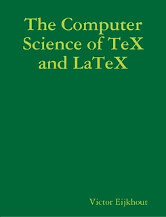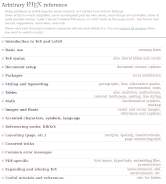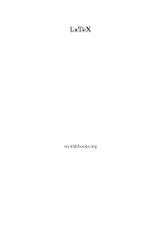Last Updated on August 17, 2024
13. The Computer Science of TeX and LaTeX by Victor Eijkhout
 The Computer Science of TeX and LaTeX uses the TeX and LaTeX system to provide an introduction to a number of computer science topics.
The Computer Science of TeX and LaTeX uses the TeX and LaTeX system to provide an introduction to a number of computer science topics.
This book is based on the lecture notes of a course taught at the University of Tennessee in the fall of 2004. This is a ‘topics’ course in computer science, using TeX and LaTeX as motivation and examples.
The contents of the book covers:
- The use of LaTeX for document preparation, LaTeX style file programming, and TeX programming.
- Learn the basic of language theory and parsing, and apply this to parsing TeX and LaTeX.
- Looks at dynamic programming, TeX paragraph breaking, TeX’s line breaking algorithm, nondeterministic polynomial time (NP) completeness, basics, complexity classes, NP-completeness, page breaking, TeX’s page breaking algorithm, theory of page breaking
- Fonts, explores Bezier curves, Parametric curves, piecewise curves, curve plotting with gnuplot, raster graphics, rasterizing type, anti-aliasing.
- TeX’s macro language – this is an unfinished chapter.
- Character encoding including ISO 10646, Unicode, UTF-8, font encoding, aesthetics, the fontenc package, and more.
- Software engineering.
- Literate programming.
The book is released under a Creative Commons Attribution 3.0 Unported (CC BY 3.0) license.
14. Arbitrary LaTeX reference by Bart
 Arbitrary LaTeX reference is a record of the author’s findings in solving problems in LaTeX.
Arbitrary LaTeX reference is a record of the author’s findings in solving problems in LaTeX.
It covers basic usage, TeX syntax, document setup, packages, styling and typesetting, tables, math, images and floats. It also looks at accented characters, symbols, languages.
Later chapters cover BibTeX, layouting, unsorted ticks, common error messages, PDF-specific issues, and more.
The license is not stated.
15. LaTeX by Wikibooks

This is a good general guide to the LaTeX markup language.
The book goes into considerable detail spanning 748 pages.
It’s intended to form a useful resource for everybody from new users who wish to learn, to old hands who need a quick reference.
This is a featured book on Wikibooks.
The contents of the book:
- Getting Started – introduction, installation, installing extra packages, basics.
- Common Elements – document structure, text formatting, paragraph formatting, colors, fonts, list structures, special characters, internationalization, rotations, tables, title creation, page layout, importing graphics, floats, figures and captions, footnotes and margin notes, hyperlinks, labels and cross-referencing.
- Mechanics – errors and warnings, lengths, counters, boxes, rules and struts.
- Technical Texts – mathematics, advanced mathematics, theorems, chemical graphics, algorithms, source code listings, linguistics.
- Special Pages – indexing, glossary, displaying the glossary, bibliography management, more bibliographies.
- Special Documents – letters, presentations, teacher’s corner, curriculum vitae.
- Creating Graphics – introducing procedural graphics, MetaPost, picture, PGF/TikZ, PSTricks, Xy-pic, creating 3D graphics.
- Programming – macros, plain TeX, creating packages, themes.
- Miscellaneous – modular documents, collaborative writing of LaTeX documents, export to other formats.
- Help and Recommendations – FAQ, tips and tricks.
- Appendices.
This book is released under the Creative Commons Attribution-ShareAlike 3.0 Unported license.
Pages in this article:
Page 1 – LaTeX Tutorials: A Primer and more books
Page 2 – Let’s Learn LaTeX and more books
Page 3 – Using LaTeX to Write a PhD Thesis and more books
Page 4 – The Computer Science of TeX and LaTeX and more books
All books in this series:
| Free Programming Books | |
|---|---|
| Ada | ALGOL-like programming language, extended from Pascal and other languages |
| Agda | Dependently typed functional language based on intuitionistic Type Theory |
| Arduino | Inexpensive, flexible, open source microcontroller platform |
| Assembly | As close to writing machine code without writing in pure hexadecimal |
| Awk | Versatile language designed for pattern scanning and processing language |
| Bash | Shell and command language; popular both as a shell and a scripting language |
| BASIC | Beginner’s All-purpose Symbolic Instruction Code |
| C | General-purpose, procedural, portable, high-level language |
| C++ | General-purpose, portable, free-form, multi-paradigm language |
| C# | Combines the power and flexibility of C++ with the simplicity of Visual Basic |
| Clojure | Dialect of the Lisp programming language |
| ClojureScript | Compiler for Clojure that targets JavaScript |
| COBOL | Common Business-Oriented Language |
| CoffeeScript | Transcompiles into JavaScript inspired by Ruby, Python and Haskell |
| Coq | Dependently typed language similar to Agda, Idris, F* and others |
| Crystal | General-purpose, concurrent, multi-paradigm, object-oriented language |
| CSS | CSS (Cascading Style Sheets) specifies a web page’s appearance |
| D | General-purpose systems programming language with a C-like syntax |
| Dart | Client-optimized language for fast apps on multiple platforms |
| Dylan | Multi-paradigm language supporting functional and object-oriented coding |
| ECMAScript | Best known as the language embedded in web browsers |
| Eiffel | Object-oriented language designed by Bertrand Meyer |
| Elixir | Relatively new functional language running on the Erlang virtual machine |
| Erlang | General-purpose, concurrent, declarative, functional language |
| F# | Uses functional, imperative, and object-oriented programming methods |
| Factor | Dynamic stack-based programming language |
| Forth | Imperative stack-based programming language |
| Fortran | The first high-level language, using the first compiler |
| Go | Compiled, statically typed programming language |
| Groovy | Powerful, optionally typed and dynamic language |
| Haskell | Standardized, general-purpose, polymorphically, statically typed language |
| HTML | HyperText Markup Language |
| Icon | Wide variety of features for processing and presenting symbolic data |
| J | Array programming language based primarily on APL |
| Java | General-purpose, concurrent, class-based, object-oriented, high-level language |
| JavaScript | Interpreted, prototype-based, scripting language |
| Julia | High-level, high-performance language for technical computing |
| Kotlin | More modern version of Java |
| LabVIEW | Designed to enable domain experts to build power systems quickly |
| LaTeX | Professional document preparation system and document markup language |
| Lisp | Unique features - excellent to study programming constructs |
| Logo | Dialect of Lisp that features interactivity, modularity, extensibility |
| Lua | Designed as an embeddable scripting language |
| Markdown | Plain text formatting syntax designed to be easy-to-read and easy-to-write |
| Objective-C | Object-oriented language that adds Smalltalk-style messaging to C |
| OCaml | The main implementation of the Caml language |
| Pascal | Imperative and procedural language designed in the late 1960s |
| Perl | High-level, general-purpose, interpreted, scripting, dynamic language |
| PHP | PHP has been at the helm of the web for many years |
| PostScript | Interpreted, stack-based and Turing complete language |
| Prolog | A general purpose, declarative, logic programming language |
| PureScript | Small strongly, statically typed language compiling to JavaScript |
| Python | General-purpose, structured, powerful language |
| QML | Hierarchical declarative language for user interface layout - JSON-like syntax |
| R | De facto standard among statisticians and data analysts |
| Racket | General-purpose, object-oriented, multi-paradigm, functional language |
| Raku | Member of the Perl family of programming languages |
| Ruby | General purpose, scripting, structured, flexible, fully object-oriented language |
| Rust | Ideal for systems, embedded, and other performance critical code |
| Scala | Modern, object-functional, multi-paradigm, Java-based language |
| Scheme | A general-purpose, functional language descended from Lisp and Algol |
| Scratch | Visual programming language designed for 8-16 year-old children |
| SQL | Access and manipulate data held in a relational database management system |
| Standard ML | General-purpose functional language characterized as "Lisp with types" |
| Swift | Powerful and intuitive general-purpose programming language |
| Tcl | Dynamic language based on concepts of Lisp, C, and Unix shells |
| TeX | Markup and programming language - create professional quality typeset text |
| TypeScript | Strict syntactical superset of JavaScript adding optional static typing |
| Vala | Object-oriented language, syntactically similar to C# |
| VHDL | Hardware description language used in electronic design automation |
| VimL | Powerful scripting language of the Vim editor |
| XML | Rules for defining semantic tags describing structure ad meaning |
